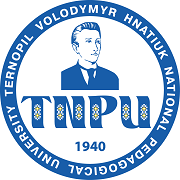MARKERS OF DOUBLE CONDITIONING IN ELIZABETH LANGESSER’S NOVEL “DAS UNAUSLÖSCHLICHE SIEGEL”
DOI:
https://doi.org/10.32782/2307-1222.2025-59-4Keywords:
German magical realism, double conditioning, Elizabeth Langgesser, transcendental discourse, oscillationAbstract
The article examines Elizabeth Langgesser’s novel “Das unauslöschliche Siegel” in the context of German magical realism, the differential feature of which is the duality of the narrative discourse, caused by the combination of real and unreal modes of presenting reality in the works of this literary genre. The conceptual basis of the study was the semiotic model of “double conditioning” by A. Koshorke, according to which two antinomic symbolic systems are paradoxically superimposed in the artistic world of the work, each of which can develop autonomously. In this case, the content integrity of the work appears only in oscillation, when a certain heterogeneous space appears, where individual elements of the plot can be simultaneously manifested in both dimensions. In the study, the specificity of duality in Elizabeth Langgesser’s novel “Das unauslöschliche Siegel” was established, the markers of transcendental discourse in the context of realism were determined. It is emphasized that the novel is dominated by a mimetic way of representation, however, the life story of the character, presented in a realistic mode, explicates a large-scale transcendental discourse: on the physical level, the life story of Lazarus Bellefontaine unfolds, on the metaphysical level – the story of the fall and salvation / spiritual resurrection and the eternal confrontation between God and his antagonist. The key concept in the work is water, which plays the role of a life-giving force, a destructive uncontrollable element, is an important attribute of the baptism ritual and a symbol of spiritual rebirth. One of the markers of double conditioning is the silver ball in the main character’s garden, which is an object of the objective world and at the same time a mystical artifact that transcends the boundaries of time and space. The metaphorical conclusion of the first part of the novel clearly demonstrates the idea of “double conditioning”: since different sign modes do not have a single meta-code, the texts cannot be deciphered by those who are in only one coordinate system, and therefore, only those whose consciousness is capable of understanding the semantics of the transcendental can oscillate between two dimensions.
References
Ковалів Ю.І. Літературознавча енциклопедія : у 2 т. Т. 2 / авт.-уклад. Ю.І. Ковалів. Київ : ВЦ «Академія», 2007. 624 с.
Bertram M. Literarische Epochendiagnosen der Nachkriegszeit. Deutsche Erinnerung: Berliner Beiträge zur Prosa der Nachkriegsjahre (1945– 1960) / hrsg. von Ursula Heukenkamp. Berlin : Erich Schmidt, 1999. S. 11–100.
Brössel St. Zeichen der Doppelbödigkeit: Filmisches Erzählen als Funktion des Magischen Realismus bei Friedo Lampe. Realisms of the Avant-Garde / ed. by M. Baßler et al. Berlin ; Boston : De Gruyter, 2020. P. 209–222. https://doi.org/10.1515/9783110637533-014.
Hoffmann D. Die Wiederkunft des Heiligen: Literatur und Religion zwischen den Weltkriegen. Paderborn ; München ; Wien ; Zürich : Ferdinand Schöningh, 1998. 458 S.
Kirchner D. Doppelbödige Wirklichkeit: magischer Realismus und nichtfaschistische Literatur. Tübingen : Stauffenburg-Verlag, 1993, 162 S.
Koschorke A. Wahrheit und Erfindung. Grundzüge einer allgemeinen Erzähltheorie. Frankfurt am Main, 2012, 480 S.
Krüger H. Nachwort. Ausgewählte Erzählungen / E. Langgässer. Hamburg ; Düsseldorf : Claassen Verlag GmbH, 1984. 358 S. S. 346.
Langgässer E. Brief an Richard Knies vom 19.12.1939. Briefe 1924–1950 / E. Langgässer ; Hrsg, von Elisabeth Hoffmann. 2 Bde. Hamburg, 1990. S. 330.
Langgässer E. Das unauslöschliche Siegel. Hamburg : Claassen Verlag GmbH, 1959. 624 S.
Langgässer E. Das unauslöschliche Siegel. Hamburg : Claassen & Goverts, 1946. 529 S. URL: https://www.projekt-gutenberg.org/langgaes/siegel/chap001.html (дата звернення: 07.11.2024).
Leine T.W. Magischer Realismus als Verfahren der späten Moderne: Paradoxien einer Poetik der Mitte. Berlin ; Boston : De Gruyter, 2018. https://doi.org/10.1515/9783110545241.
Mülverstedt C. Denn das Thema der Dichtung ist immer der Mensch. Entindividualisierung und Typologisierung im Romanwerk Elisabeth Langgässers. Königshausen u. Neumann, 2000. 236 S.
Rinser L. Magische Argonautenfahrt. Schweizer Monatshefte: Zeitschrift für Politik, Wirtschaft, Kultur. Band 39. 1959–1960. Heft 5. S. 432–445.
Rinser L. Nachwort. Im Scheitern ist Erfüllung. Märkische Argonautenfahrt / E. Langgässer. Frankfurt am Main ; Berlin ; Wien : Ullstein Werkausgaben, 1981. S. 413–416.
Scheffel M. Magischer Realismus. Die Geschichte eines Begriffes und ein Versuch seiner Bestimmung. Staffenburg Colloquiun. 16. Tübingen, 1990. 187 S.










